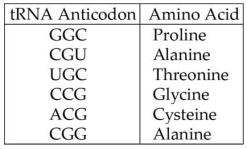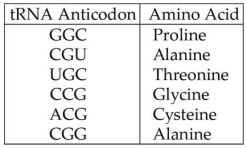A) met-arg-glu-arg-glu-arg
B) met-glu-arg-arg-glu-leu
C) met-ser-leu-ser-leu-ser
D) met-ser-ser-leu-ser-leu
Correct Answer

verified
Correct Answer
verified
Multiple Choice
The most commonly occurring mutation in people with cystic fibrosis is a deletion of a single codon.What is the most likely result of this mutation in the protein product?
A) a base-pair substitution
B) a nucleotide mismatch
C) a frameshift mutation
D) a polypeptide missing an amino acid
Correct Answer

verified
Correct Answer
verified
Multiple Choice
Which component is not directly involved in translation?
A) GTP
B) DNA
C) tRNA
D) ribosomes
Correct Answer

verified
B
Correct Answer
verified
Multiple Choice
Suppose that an error in transcription alters the formation of a single tRNA molecule in a cell.The altered tRNA still attaches to the same amino acid (Phe) ,but its anticodon loop has the sequence AAU,which binds to the mRNA codon UUA (usually specifying the amino acid leucine,Leu) .What will be the effect on the translation of polypeptides in this cell?
A) The altered tRNA will cause this mRNA to make only nonfunctioning product.
B) The tRNA-Leu will not be able to enter the ribosome to bind to the UUA codon.
C) One altered tRNA molecule will have little effect because it will compete with many "normal" ones.
D) The altered tRNA will result in an amino acid variant in all copies of the protein.
Correct Answer

verified
Correct Answer
verified
Multiple Choice
In what way could a point mutation in DNA make a difference in the function of a protein?
A) It might result in a chromosomal translocation.
B) It might exchange one stop codon for another stop codon.
C) It might exchange one serine codon for a different serine codon.
D) It might substitute a different amino acid in the protein,which could change its function.
Correct Answer

verified
Correct Answer
verified
Multiple Choice
Which of the following statements describes one of the functions of GTP in translation?
A) GTP provides the energy for the formation of the initiation complex,using initiation factors.
B) GTP is hydrolyzed to provide phosphate groups for tRNA binding.
C) GTP is hydrolyzed to provide energy for breaking peptide bonds.
D) GTP supplies phosphates and energy to make ATP from ADP.
Correct Answer

verified
Correct Answer
verified
Multiple Choice
Use the following model of a eukaryotic transcript to answer the question.E1-4 refer to the exons,and I1-3 refer to the introns in the pre-mRNA transcript. 5' UTR E1 I1 E2 I2 E3 I3 E4 UTR 3' Which components of the previous molecule will also be found in mRNA in the cytosol?
A) 5' UTR I1 I2 I3 UTR 3'
B) 5' E1 E2 E3 E4 3'
C) 5' UTR E1 E2 E3 E4 UTR 3'
D) 5' I1 I2 I3 3'
Correct Answer

verified
Correct Answer
verified
Multiple Choice
Which of the following types of mutations could result in a frameshift mutation?
A) a base insertion only
B) a base deletion only
C) a base substitution only
D) either an insertion or a deletion of a base
Correct Answer

verified
Correct Answer
verified
Multiple Choice
Which of the following mutations is most likely to cause a phenotypic change?
A) a duplication of all or most introns
B) a nucleotide substitution in an exon coding for a transmembrane protein
C) a single nucleotide deletion in an exon coding for an active site of a protein
D) a frameshift mutation one codon away from the 3' end of the nontemplate strand
Correct Answer

verified
Correct Answer
verified
Multiple Choice
Which of the following experimental procedures is most likely to speed up mRNA degradation in a eukaryotic cell?
A) lengthening of the poly-A tail
B) removal of the 5' cap
C) removal of C nucleotides
D) removal of one or more exons
Correct Answer

verified
Correct Answer
verified
Multiple Choice
A part of an mRNA molecule with the following sequence is being read by a ribosome: 5'-CCG-ACG-3' (mRNA) .The charged transfer RNA molecules shown in the figure below (with their anticodons shown in the 3' to 5' direction) are available.Two of them can correctly match the mRNA so that a dipeptide can form.  The anticodon loop of the first tRNA that will complement this mRNA is
The anticodon loop of the first tRNA that will complement this mRNA is
A) 3'-GGC-5'.
B) 5'-GGC-3'.
C) 5'-ACG-3'.
D) 5'-UGC-3'.
Correct Answer

verified
Correct Answer
verified
Multiple Choice
A particular triplet of bases in the coding sequence of DNA is AAA.The anticodon on the tRNA that binds the mRNA codon is
A) TTT.
B) UUA.
C) UUU.
D) AAA.
Correct Answer

verified
Correct Answer
verified
Multiple Choice
Which of the following descriptions of nucleotide triplets best represents a codon?
A) a triplet separated spatially from other triplets
B) a triplet that has no corresponding amino acid
C) a triplet at the opposite end of tRNA from the attachment site of the amino acid
D) a triplet in the same reading frame as an upstream AUG
Correct Answer

verified
D
Correct Answer
verified
Multiple Choice
What is a ribozyme?
A) an enzyme that uses RNA as a substrate
B) an RNA with enzymatic activity
C) an enzyme that catalyzes the association between the large and small ribosomal subunits
D) an enzyme that synthesizes RNA as part of the transcription process
Correct Answer

verified
Correct Answer
verified
Multiple Choice
Which of the following processes only occurs in eukaryotic gene expression?
A) mRNA,tRNA,and rRNA are transcribed.
B) RNA polymerase binds to the promoter.
C) A poly-A tail is added to the 3' end of an mRNA,and a cap is added to the 5' end.
D) Transcription can begin as soon as translation has assembled the first few amino acids in the polypeptide.
Correct Answer

verified
C
Correct Answer
verified
Multiple Choice
Which of the following statements best describes the function of the TATA box in eukaryotic promoters?
A) It is the recognition site for a specific transcription factor.
B) It sets the reading frame of the mRNA.
C) It is the recognition site for ribosomal binding.
D) It signals the end of the nucleotide sequence of the gene.
Correct Answer

verified
Correct Answer
verified
Multiple Choice
During transcription of the DNA in the figure above,where would the promoter be located?
A) at the 3' end of the newly made RNA
B) to the right of the template strand
C) to the left of the template strand
D) to the right of the coding strand
Correct Answer

verified
Correct Answer
verified
Multiple Choice
A part of an mRNA molecule with the following sequence is being read by a ribosome: 5'-CCG-ACG-3' (mRNA) .The charged transfer RNA molecules shown in the figure below (with their anticodons shown in the 3' to 5' direction) are available.Two of them can correctly match the mRNA so that a dipeptide can form.  The dipeptide that will form will be
The dipeptide that will form will be
A) cysteine-alanine.
B) proline-threonine.
C) glycine-cysteine.
D) alanine-alanine.
Correct Answer

verified
Correct Answer
verified
Multiple Choice
A transfer RNA (#1) attached to the amino acid lysine enters the ribosome.The lysine binds to the growing polypeptide on the other tRNA (#2) already in the ribosome.Which component of the complex described enters the exit tunnel through the large subunit of the ribosome?
A) tRNA with attached lysine (#1)
B) tRNA with polypeptide (#2)
C) tRNA that no longer has attached amino acid
D) newly formed polypeptide
Correct Answer

verified
Correct Answer
verified
Multiple Choice
Which of the following statements correctly compares transcription in prokaryotes and eukaryotes?
A) Prokaryotes have at least three types of RNA polymerases,whereas eukaryotes only have one.
B) Bacteria have one type of RNA polymerase,whereas eukaryotes have at least three.
C) RNA polymerase in both prokaryotes and eukaryotes produce the same RNA molecules.
D) Both eukaryotes and prokaryotes recognize a polyadenylation signal in order to terminate transcription.
Correct Answer

verified
Correct Answer
verified
Showing 1 - 20 of 77
Related Exams